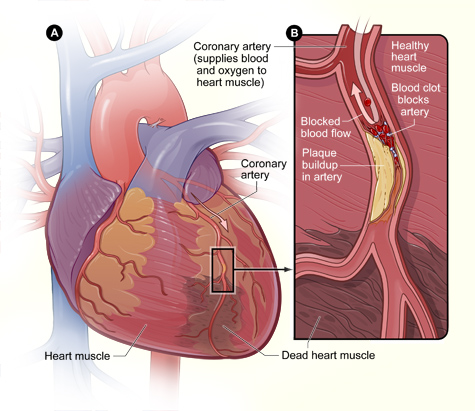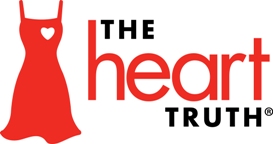How Does Heart Disease Affect Women?
In the United States, 1 in 4 women dies from heart disease. In fact, coronary heart disease (CHD)—the most common type of heart disease—is the #1 killer of both men and women in the United States.
Other types of heart disease, such as coronary microvascular disease (MVD) and broken heart syndrome, also pose a risk for women. These disorders, which mainly affect women, are not as well understood as CHD. However, research is ongoing to learn more about coronary MVD and broken heart syndrome.
This article focuses on CHD and its complications. However, it also includes general information about coronary MVD and broken heart syndrome.
Coronary Heart Disease
CHD is a disease in which plaque (plak) builds up on the inner walls of your coronary arteries. These arteries carry oxygen-rich blood to your heart. When plaque builds up in the arteries, the condition is called atherosclerosis (ath-er-o-skler-O-sis).
Plaque is made up of fat, cholesterol, calcium, and other substances found in the blood. Over time, plaque can harden or rupture (break open).
Hardened plaque narrows the coronary arteries and reduces the flow of oxygen-rich blood to the heart. This can cause chest pain or discomfort called angina (an-JI-nuh or AN-juh-nuh).
If the plaque ruptures, a blood clot can form on its surface. A large blood clot can mostly or completely block blood flow through a coronary artery. This is the most common cause of a heart attack. Over time, ruptured plaque also hardens and narrows the coronary arteries.
Heart With Muscle Damage and a Blocked Artery

Figure A is an overview of a heart and coronary artery showing damage (dead heart muscle) caused by a heart attack. Figure B is a cross-section of the coronary artery with plaque buildup and a blood clot resulting from plaque rupture.
Plaque also can develop within the walls of the coronary arteries. Tests that show the insides of the coronary arteries may look normal in people who have this pattern of plaque. Studies are under way to see whether this type of plaque buildup occurs more often in women than in men and why.
In addition to angina and heart attack, CHD can cause other serious heart problems. The disease may lead to heart failure, irregular heartbeats called arrhythmias (ah-RITH-me-ahs), and sudden cardiac arrest (SCA).
Coronary Microvascular Disease
Coronary MVD is heart disease that affects the heart's tiny arteries. This disease is also called cardiac syndrome X or nonobstructive CHD. In coronary MVD, the walls of the heart's tiny arteries are damaged or diseased.
Coronary Microvascular Disease

Figure A shows the small coronary artery network (microvasculature), containing a normal artery and an artery with coronary MVD. Figure B shows a large coronary artery with plaque buildup.
Women are more likely than men to have coronary MVD. Many researchers think that a drop in estrogen levels during menopause combined with other heart disease risk factors causes coronary MVD.
Although death rates from heart disease have dropped in the last 30 years, they haven't dropped as much in women as in men. This may be the result of coronary MVD.
Standard tests for CHD are not designed to detect coronary MVD. Thus, test results for women who have coronary MVD may show that they are at low risk for heart disease.
Research is ongoing to learn more about coronary MVD and its causes.
Broken Heart Syndrome
Women are also more likely than men to have a condition called broken heart syndrome. In this recently recognized heart problem, extreme emotional stress can lead to severe (but often short-term) heart muscle failure.
Broken heart syndrome is also called stress-induced cardiomyopathy (KAR-de-o-mi-OP-ah-thee) or takotsubo cardiomyopathy.
Doctors may misdiagnose broken heart syndrome as a heart attack because it has similar symptoms and test results. However, there's no evidence of blocked heart arteries in broken heart syndrome, and most people have a full and quick recovery.
Researchers are just starting to explore what causes this disorder and how to diagnose and treat it. Often, patients who have broken heart syndrome have previously been healthy.
Outlook
Women tend to have CHD about 10 years later than men. However, CHD remains the #1 killer of women in the United States.
The good news is that you can control many CHD risk factors. CHD risk factors are conditions or habits that raise your risk for CHD and heart attack. These risk factors also can increase the chance that existing CHD will worsen.
Lifestyle changes, medicines, and medical or surgical procedures can help women lower their risk for CHD. Thus, early and ongoing CHD prevention is important.
More information about heart disease in women is available through the National Heart, Lung, and Blood Institute's The Heart Truth® campaign.
____________
®The Heart Truth and its logo are registered trademarks of the U.S. Department of Health and Human Services (HHS).
Featured Video
The Heart Truth®
-
 The Heart Truth®
The Heart Truth®
02/01/2012 -
 Heart Attack Warning Symptoms
Heart Attack Warning Symptoms
10/20/2011 -
 Heart Disease Risk Factors
Heart Disease Risk Factors
09/30/2011
Have questions about how heart disease affects women in the Hispanic community? Join The Heart Truth®, the American Heart Association , Discovery Familia, and Siempre Mujer for a Spanish-language Facebook chat on February 13 at 1 p.m. ET. Get tips from experts on how to keep your whole family healthy, share your story of making preventive changes in your family, and ask live experts your questions. For more information, visit The Heart Truth on Facebook.
Clinical trials are research studies that explore whether a medical strategy, treatment, or device is safe and effective for humans. To find clinical trials that are currently underway for Heart Disease in Women, visit www.clinicaltrials.gov.
February 1, 2013
NIH urges women to protect their heart health and to encourage others to do the same
Women and men across the country will kick off the month on Friday, Feb. 1 by participating in the 11th annual National Wear Red Day, which encourages all Americans to wear red to show their support for raising awareness of women's heart disease.

The Heart Truth®—a national heart disease awareness campaign for women—is sponsored by the NHLBI. The campaign's goal is to give women a personal and urgent wakeup call about their risk for heart disease.
Every woman has a story to tell and the power to take action to protect her heart health. Share your story with other women on Facebook.
The Heart Truth campaign offers a variety of public health resources to help educate women and health professionals about women’s heart disease.
Learn more about key campaign events, activities, and resources at www.hearttruth.gov.
The NHLBI updates Health Topics articles on a biennial cycle based on a thorough review of research findings and new literature. The articles also are updated as needed if important new research is published. The date on each Health Topics article reflects when the content was originally posted or last revised.















